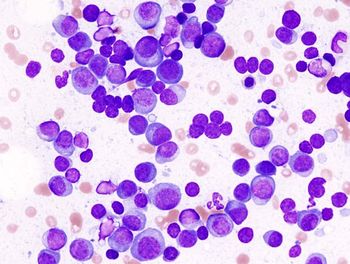
Cross Q&A: Exploring the Role of Ixazomib in Relapsed/Refractory Multiple Myeloma
Key insights on real-world applications of the REMIX study, which evaluated real-world effectiveness and tolerability of the ixazomib-based regimen in relapsed/refractory multiple myeloma.
Episodes in this series

Transcript:
Judy Schreiber, PhD, RN: Thank you so much, Dr Liu. What’s the response from Seattle?
Andrew J. Cowan, MD: Thanks, Dr Liu. That was an excellent presentation. I’ll start off by saying I suspect that our practices, [regarding the] use of ixazomib and immunomodulatory agents in the relapsed setting, are somewhat similar. I’ve used a fair bit of ixazomib. My general take on the drug is that it is effective, but I have tended to [use] it more often in patients who have issues getting to the infusion center or, as you mentioned, [are] older [and] [frailer]. I suspect my experience is somewhat biased by that. But…in light of these data, Dr Liu and Dr Janakiram, what do you feel…is the optimal patient population to use this in? If you had a choice between a proteasome inhibitor [PI] like carfilzomib [Kyprolis] or bortezomib [Velcade], what would make you think more strongly about ixazomib in a given patient?
Lawrence W. Liu, MD: I can speak to that a little bit…. There [are] just so many options in multiple myeloma, which also is great to cater the treatments to what the patient’s needs are. Like you mentioned, the fact that it’s a completely oral-based regimen…really adds to the convenience, especially for an older and maybe frailer population. I really like that they have data on the dose reductions and treatment pauses. It…gives you that security to know there [are] other things you can do. [Regarding] the panel of [adverse] effects, it’s also great to have another option to work with patients on this.
Murali Janakiram, MD, MS: I would reflect [on] our experiences as well, Dr Cowan. I use ixazomib in a very similar population at this time, which is frail [patients] who have issues in getting to the hospital or [whose] blood tests do not have to be monitored…. The difficulty with the ixazomib trials [has] been that most of the trials have shown an improved PFS [progression-free survival] but not necessarily an improvement in overall survival [OS], even when compared [with] the [second]-line setting. I think that is the difficulty in all the ixazomib trials.
Thinking about this, I then ask myself: Is the drug effective? Which is the first question to ask. And very often, even from the doublet trials, I think the drug is effective. Then why has it not shown an improvement in [OS]? My best guess is the change in time periods and subsequent lines of therapy, which [have] changed over time. I think with stronger and stronger subsequent lines of therapy, the [OS] hasn’t changed…but the [PFS] has changed. If I [must] rank the other drugs—daratumumab, carfilzomib, and ixazomib—I still think daratumumab and carfilzomib have better PFS data than ixazomib. These are the reasons why I’m selecting ixazomib below daratumumab and carfilzomib at this time.
Rahul Banerjee, MD, FACP: This is an excellent presentation, Dr Liu. You brought up GRIFFIN [NCT02874742], which I think is really, to Dr Janakiram and Dr Cowan’s point…the more modern era here. A lot of our patients will be on lenalidomide maintenance or, possibly in the future, daratumumab plus lenalidomide, depending on how the AURIGA study [NCT03901963] and how the rest of GRIFFIN read out. Are there patients on lenalidomide or daratumumab plus lenalidomide, where you would go to ixa-len-dex [ixazomib, lenalidomide, dexamethasone]? Or [would this] be for patients who are on bortezomib maintenance or no maintenance? Where would you use ixazomib, lenalidomide, [and] dexamethasone in second-line therapy?
Lawrence W. Liu, MD: I do wish they had more data [regarding] the lenalidomide-refractory population, [because] they reported on [only] 6 patients…. It needs a higher sample size to really analyze [because], yes, it did suggest the median PFS falls somewhere between 9 [and] 12, but only [in] 6 patients. I probably would choose a different regimen if I’m sure that the patient was refractory to lenalidomide. If they were just exposed, the data [were] still pretty solid for this regimen…. Looking into the data in triplet regimens with daratumumab and carfilzomib—they do have a better efficacy profile, but the tolerability of this regimen was still good. That would be my thoughts on that.
Andrew J. Cowan, MD: Part of the reason why we see effectiveness of ixazomib in this relapsed setting is because many of the patients [who] haven’t been on a [PI] for a long time. And they’re not refractory to a PI. So if you’re going to use ixazomib, this would be probably the time to use it because [in] later lines of therapy, they’re going to be refractory to [carfilzomib] and [bortezomib]. If you have a patient [in whom] you’re going to use it, then use it, because that’s when it’s probably going to have the best effectiveness. That’s my take.
Murali Janakiram, MD, MS: Yes, I agree. I think this would be for patients who are progressing on lenalidomide maintenance—a slow progression—but still want to maintain that quality of life and do the things they want to do. I think that is another good patient population [in which] we can add the ixazomib…. I tend not to increase the dose of lenalidomide if I know they’re relapsing. I treat it either as a relapse or not a relapse and just watch and wait. I think that is where ixazomib also has a role. And it’s a good question regarding whether there’s a selective patient population, Dr Banerjee.
Judy Schreiber, PhD, RN: Thank you very much.
Transcript is AI generated and edited for clarity and readability.
Newsletter
Stay up to date on recent advances in the multidisciplinary approach to cancer.




















































































